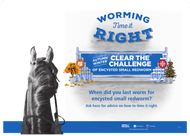Zoetis Encysted Small Redworm - A Horse Owners Leaflet
Posted by Darren Walton on 10th Feb 2016
For a full list of products go to our horse wormers page
Don't let Encysted Small Redworm creep up on you.
Encysted small redworm larvae can remain hidden in the wall of the horses gut and can account for 90% of the redworm burden in a horse.
Encysted small redworms are the most common and harmful worms found in horses, with the larval stages of this parasite giving the greatest cause for concern.2 Small redworm larvae can encyst within the gut wall throughout the year – especially in Autumn and Winter. Typically, sudden mass emergence will occur in Spring and can cause diarrhoea and colic.3 This condition is known as larval cyathostominosis, which can be life-threatening.*1 Control needs to be focused on all stages of the parasite’s lifecycle, with specific attention paid to the encysted larvae.

